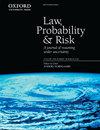Chinese Law and Development
IF 1.4
4区 社会学
Q1 LAW
引用次数: 12
Abstract
The 2020 coronavirus pandemic has cast doubt on taken-for-granted economic and governance models. Against the backdrop of increasing tension between the United States and the People’s Republic of China (PRC or China), China is presenting itself as an alternative center for governance. Pursuant to these seismic shifts, the analysis must attune to how China creates cross-border order. Whereas scholars have examined China’s use of trade and investment law, inadequate attention has been paid to how the PRC grapples with the domestic law of host states. As the PRC seeks to protect its investments abroad, it is confronted with questions of law and development, yet there is little understanding of China’s approach or what it means for host states, developed economies, and global governance. This Article seeks to fill that gap. “Chinese law and development” (CLD) consists of transnational law, some of which builds on legal infrastructures from the U.S. and some of which is Chinese, along with extralegal and nonlegal norms. These normative orders mitigate risk as a precondition to promoting China’s interests overseas. Drawing on three years of fieldwork and nearly 150 interviews in China and in host states, this Article presents the first empirical study of CLD to articulate an analytical theory to understand this phenomenon. In assessing CLD, I query whether CLD is good for developing states, and identify a research agenda for the study of the legal and regulatory dimensions of Chinese economic globalization.中国的法律与发展
2020年冠状病毒大流行使人们对想当然的经济和治理模式产生了怀疑。在美国和中华人民共和国(PRC或China)之间日益紧张的背景下,中国正在将自己展示为另一个治理中心。根据这些巨大的变化,分析必须调整到中国如何建立跨境秩序。虽然学者们研究了中国对贸易和投资法的使用,但对中国如何应对东道国的国内法的关注不够。当中国寻求保护其海外投资时,它面临着法律和发展的问题,但人们对中国的做法及其对东道国、发达经济体和全球治理的意义知之甚少。本文试图填补这一空白。“中国法律与发展”(CLD)包括跨国法,其中一些建立在美国的法律基础上,一些是中国的法律基础,以及法外和非法律规范。这些规范秩序作为促进中国海外利益的先决条件,降低了风险。通过三年的实地调查和在中国和东道国进行的近150次访谈,本文首次提出了对CLD的实证研究,以阐明分析理论来理解这一现象。在评估CLD时,我质疑CLD是否对发展中国家有利,并确定了研究中国经济全球化的法律和监管层面的研究议程。
本文章由计算机程序翻译,如有差异,请以英文原文为准。
求助全文
约1分钟内获得全文
求助全文
来源期刊

Law Probability & Risk
MATHEMATICSSTATISTICS & PROBABILITY&-STATISTICS & PROBABILITY
CiteScore
2.10
自引率
28.60%
发文量
8
期刊介绍:
Law, Probability & Risk is a fully refereed journal which publishes papers dealing with topics on the interface of law and probabilistic reasoning. These are interpreted broadly to include aspects relevant to the interpretation of scientific evidence, the assessment of uncertainty and the assessment of risk. The readership includes academic lawyers, mathematicians, statisticians and social scientists with interests in quantitative reasoning.
The primary objective of the journal is to cover issues in law, which have a scientific element, with an emphasis on statistical and probabilistic issues and the assessment of risk.
Examples of topics which may be covered include communications law, computers and the law, environmental law, law and medicine, regulatory law for science and technology, identification problems (such as DNA but including other materials), sampling issues (drugs, computer pornography, fraud), offender profiling, credit scoring, risk assessment, the role of statistics and probability in drafting legislation, the assessment of competing theories of evidence (possibly with a view to forming an optimal combination of them). In addition, a whole new area is emerging in the application of computers to medicine and other safety-critical areas. New legislation is required to define the responsibility of computer experts who develop software for tackling these safety-critical problems.
 求助内容:
求助内容: 应助结果提醒方式:
应助结果提醒方式:


